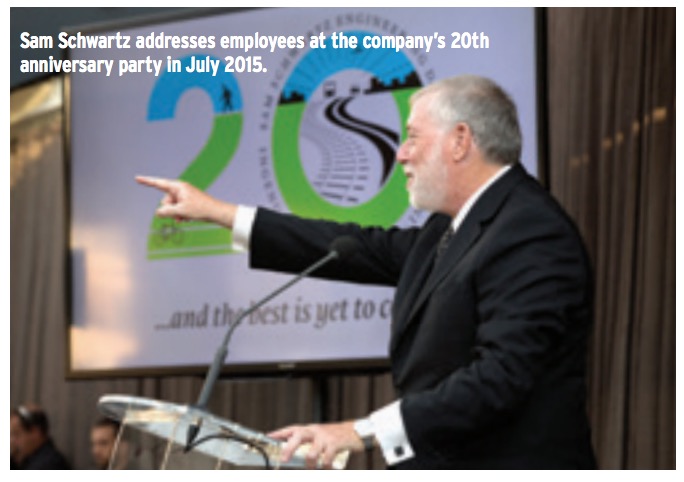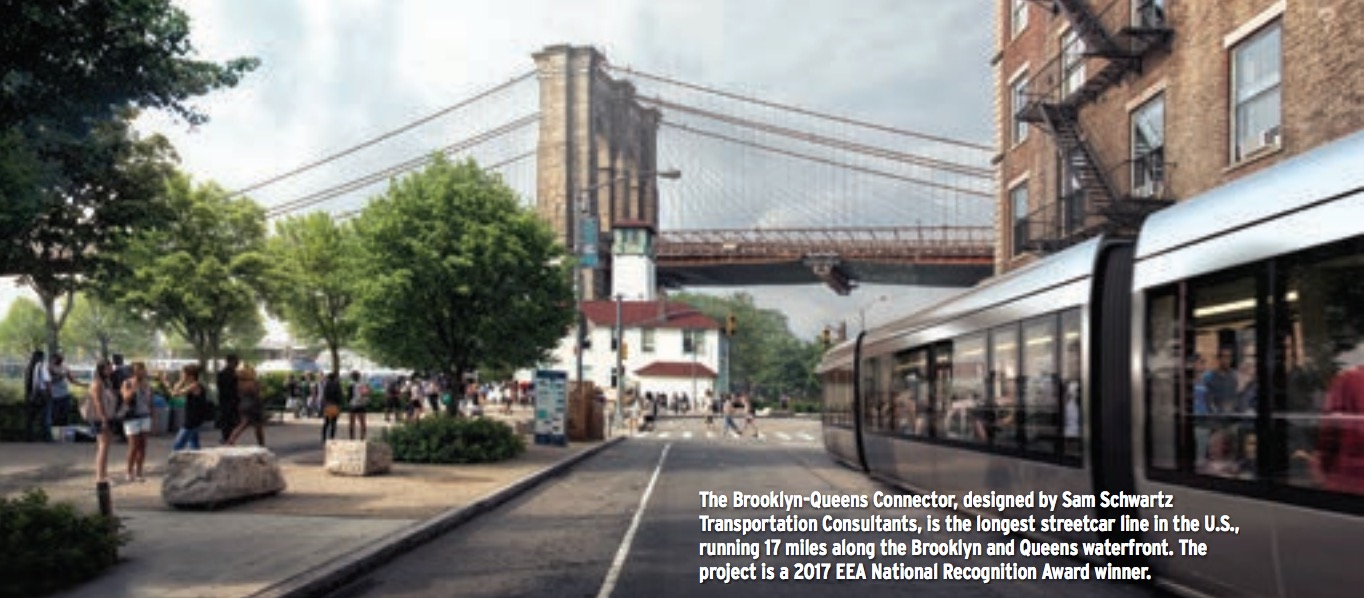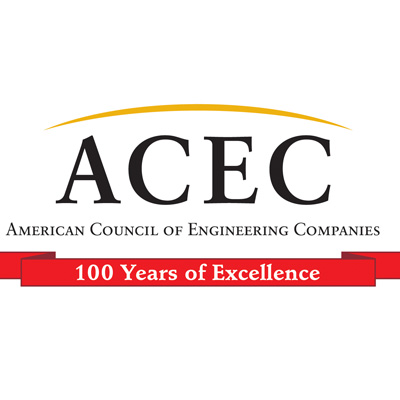AMERICAN COUNCIL OF ENGINEERING COMPANIES (ACEC)
An unparalleled flair for problem-solving has made Sam Schwartz an icon of traffic engineering
Written by Gerry Donohue, ACEC’s senior communications writer
Sam Schwartz is not your typical traffic engineer. What Traffic engineer, after all, would say his proudest achievement is the bridge he didn’t build?
 In 1988, as first deputy commissioner of the New York City Department of Transportation, Schwartz had to close the 85-year-old Williamsburg Bridge, which spans the East River between Brooklyn and Manhattan, after inspectors found dangerous deterioration. With repair costs topping $700 million, the city and state turned to the federal government. The U.S. Department of Transportation (USDOT) was willing to provide funding but insisted that a new bridge be built because the existing structure was unsafe and substandard due to its 9-foot traffic lanes.
In 1988, as first deputy commissioner of the New York City Department of Transportation, Schwartz had to close the 85-year-old Williamsburg Bridge, which spans the East River between Brooklyn and Manhattan, after inspectors found dangerous deterioration. With repair costs topping $700 million, the city and state turned to the federal government. The U.S. Department of Transportation (USDOT) was willing to provide funding but insisted that a new bridge be built because the existing structure was unsafe and substandard due to its 9-foot traffic lanes.
Schwartz disagreed for three reasons. He didn’t want to build a bigger bridge because it would put more cars on the road in the nation’s most crowded city. Building a bridge with 12-foot lanes and shoulders would also require razing the neighborhoods at each end—Brooklyn’s Williamsburg and Manhattan’s Lower East Side. And finally, he disputed that the narrow lanes were “substandard.”
Schwartz and his team analyzed crashes on the bridge and found that accidents actually occurred at a higher rate in the wider stretches of the bridge. “My explanation,” he says, “is that when lanes get very narrow, motorists drive more carefully.” Armed with that analysis, Schwartz swayed the USDOT and rebuilt the bridge within its existing footprint.
“The Williamsburg Bridge, narrow lanes and all, was saved,” he says. “And so were Williamsburg and the Lower East Side, which are today two of the most vibrant and prosperous neighborhoods in the entire country.”
According to ACEC/New York President Jay Simson, that is typical Schwartz. “From his days working in the city DOT to today with his own firm, Sam has always looked beyond the specifics of each individual project, focusing on the bigger picture,” Simson says. “And that focus is supported by a solid foundation of facts and experience.”
Serving the Public
Schwartz came by that experience honestly, driving a cab in New York City during the mid-1960s while he studied physics at Brooklyn College. He went on to get a graduate degree in transportation engineering at the University of Pennsylvania, and then in 1971, started working for the New York City Department of Traffic as a junior engineer.
It was a tough time in the Big Apple. The city was cash-strapped and its infrastructure was deteriorating at an alarming rate. In his first few years, he had to deal with the West Side Highway collapse, the brush with municipal bankruptcy and the city’s tangled efforts to conform to the Clean Air Act. Working with Mayor John Lindsay, he developed a plan to ban cars from Midtown Manhattan, only to have it tabled weeks before its implementation.
In 1982, he was named New York City traffic commissioner, where he led a much-publicized fight against parking-fine-scofflaw diplomats at the United Nations. Then in 1986, when a kickback scandal brought down almost everyone else in the city’s Department of Transportation hierarchy, he was named first deputy commissioner of the city’s Department of Transportation, as well as chief engineer. It was during this tenure that he fought to save the Williamsburg Bridge.
Schwartz left public service in 1990, and after a short stint at Hayden Wegman Consulting Engineers, put out his own shingle in 1995. Sam Schwartz Transportation Consultants currently employs about 120 people and has offices in New York, Newark, Chicago, Los Angeles, Washington, D.C., Philadelphia and Tampa, Florida.
“Working in government was a great education,” says Schwartz. “You deal with things that no one in the private sector has to deal with—all the obstacles placed in the way of public engineers.”
Building a Firm
Erich Arcement joined Schwartz’s firm 22 years ago as an intern. Today he is a senior vice president, heading up some of the firm’s bigger projects, including traffic engineering for the $4 billion renovation of LaGuardia Airport.
In recent years, the firm has provided traffic and project expertise for the new Second Avenue Subway in New York, the pope’s visit to Philadelphia and several presidential inaugurations. During reconstruction in the wake of the 9/11 attack on the World Trade Center, the firm helped to restore transportation access to the site and the surrounding streets.
“We often get called into major projects that are having difficulties,” Arcement says. “Sam is a big thinker. He looks at everything holistically, isn’t afraid to test the boundaries of what can be done, and searches for creative ways to solve problems.”
One of the firm’s areas of expertise is community relations, finding innovative ways to engage and incorporate community input into the project. On the Second Avenue Subway project, for example, the community wasn’t happy. “There was a lot of surface street construction, but all the progress was happening below grade,” says Arcement.
The firm opened up a storefront community information center, organized street fairs and even organized tours below grade to show people the work that was being done.
“We were able to get people excited and more interested in the project,” says Arcement. “Equally important, though, is we listened to their concerns and recommendations and incorporated them into the project going forward.”
Schwartz attracts like-minded people to the firm, says Arcement. “They find their way here. They know the work we do and the ethos of the company, and they want to work here.
“Every year we have an internal company slogan,” he says. “A few years ago it was, ‘We are bigger than we are.’ To me that really sets the tone of our company. We want to create something bigger than ourselves.”

Making a Difference
Schwartz has always had an outsized presence in his endeavors. “He is, inarguably, the most beloved transportation engineer alive,” says Charles Komanoff, a New York City transport economist, who then adds with a smile, “Admittedly, there’s not much competition.”
Schwartz, for example, is credited with inventing the word “gridlock,” although he is always quick to credit the initial use of the word to a colleague. Schwartz, however, brought it into the public space and soon came to be known as “Gridlock Sam.”
Since 1990, he has been writing a Gridlock Sam column in the New York Daily News, answering questions from commuters and commenting on transportation issues in the New York City metropolitan area. He also has a Twitter feed in which he regularly tweets traffic and transit service updates from around the city.
“Sam has a unique skill set,” says Charlie Gozdziewski, executive chairman of Hardesty & Hanover in New York City. “He’s an excellent engineer, a great communicator, and he has substantial political skills. He checks all the boxes.”
Schwartz is applying those skills right now as one of the prime forces behind the Move New York initiative, which has its genesis all the way back to the plan that he and Mayor Lindsay developed in the mid-1970s to ease Manhattan’s gridlock.
“Move New York is a program to overhaul and reform the toll regime in the city of New York in a way that would vastly reduce traffic gridlock and improve public transportation,” says Komanoff.
The program would toll all the routes in and out of the Manhattan Central Business District (CBD) and the four East River bridges while at the same time reducing the tolls on bridges in the outer boroughs.
“Most residents from the outer boroughs don’t drive regularly into the Manhattan CBD, but they pay high tolls to cross the outer-borough bridges because there aren’t any mass transit alternatives,” says Komanoff. “Sam came up with a solution that would take away this unfairness and generate so much more revenue that it would revive capital investment in the subways, buses and commuter rails.”
ACEC/New York has backed the Move New York initiative from the beginning. Despite opposition at the state level, Simson says, “I think it can get done. And Sam deserves a lot of credit for that because of his history and credibility.”
Leaving a Legacy
Schwartz has expanded his notoriety beyond New York City and outside the engineering industry with the publication in 2015 of Street Smart: The Rise of Cities and The Fall of Cars. Part autobiography, part manifesto, the book tracks the rise of the automobile to its current status of cultural dominance and then looks at what the future might hold.
While Schwartz doesn’t doubt the continued primacy of the car in America, he says we are in a time of huge transition. “We have never seen such a rapid change in transportation as in the past five years, and I expect the pace of change to accelerate,” he says. “It’s even more dramatic than Henry Ford’s making automobiles affordable or the building of the Interstate Highway System.”
In the book, he focuses on three related developments: the decline in driving among millennials, the growth of mobility as a service (MAAS) and the promise of automated vehicles (AV).
Schwartz highlights the 25 percent decline in driving miles by millennials in the early 2000s—the first generational decline in history. He attributes much of that decline to millennials’ preference for urban living, with its plethora of transportation alternatives, including mass transit.
“In spite of this trend, however, we’re still seeing highway expansion programs,” he says. “The federal government talks only about highway and bridge improvements and nothing about transit at all.”
Many cities, on the other hand, have recognized the value of attracting millennials. “There is a close correlation between millennials and technology centers and the GDP of cities,” he says. “Cities like Boise and Fargo are recognizing that the ways of the past are not what young people today desire. They want walkable and bikeable cities. They want transit systems.”
In the years since he wrote the book, millennial driving has inched up, says Schwartz, due to lower unemployment and plummeting gas prices, but the overall decline in millennial driving remains. “Especially among younger millennials,” he says.
Millennials also have helped to fuel the rapid expansion of MAAS through companies such as Uber and Lyft. While he is a big fan of MAAS, Schwartz says it’s not an unqualified positive.
“The free market element should be part of MAAS, but society also has to have a voice in how we want to do this,” he says. “We didn’t do that with Uber [in New York City]. The city was caught flat-footed. The number of MAAS trips now exceeds taxi fares, vehicle miles traveled in the city has increased by 7 percent, and traffic speeds in Midtown are down by 20 percent. We’re strangling here.”
He says MAAS has a lot of space to grow beyond app-based car sharing services. “We’re working with Ford, which is looking to transform itself from a motor company to a mobility company,” says Schwartz. “They clearly recognize that in 20 years their business will be fewer cars and more mobility as a service.”
The biggest development, however, will undoubtedly be autonomous vehicles.
“I’m impressed with the speed at which they’re coming to the market, but they will have a long way to go,” he says. “If you were to say that Stage 5 will be the driver never being called upon to do anything, then I would say we’re only at Stage 1 right now.” He predicts the market will reach Stage 5 within 20 years.
Engineers, though, need to start preparing now, says Schwartz. “We’re going to need to adapt to AV,” he says. “Calculations for infrastructure are going to have to come down significantly. Lanes will be narrower and capacities will increase. Will we need one-way streets anymore? Lanes? I think the vehicles will just figure it out.”
And it’s not just infrastructure. The combination of MAAS and AV will mean far fewer cars on the roads and less need for parking. “The parking garages we build today will need to be something else in 20 years,” he says. “What if, for example, we built garages that could be easily converted to residential?”
No, Schwartz is not your typical traffic engineer.
Download full article: The Enduring Legend of Gridlock Sam
Download September/October Issue of Engineering, Inc.
 About the American Council of Engineering Companies
About the American Council of Engineering Companies
www.acec.org
The American Council of Engineering Companies (ACEC) is the voice of America’s engineering industry. Council members – numbering more than 5,000 firms representing more than 500,000 employees throughout the country – are engaged in a wide range of engineering works that propel the nation’s economy, and enhance and safeguard America’s quality of life. These works allow Americans to drink clean water, enjoy a healthy life, take advantage of new technologies, and travel safely and efficiently. The Council’s mission is to contribute to America’s prosperity and welfare by advancing the business interests of member firms.
Tags: ACEC, American Council of Engineering Companies, Engineering Inc., Engineers, Gerry Donohue, Gridlock Sam, New York City, NY, NYC, Sam Schwartz, Sam Schwartz Engineering, Traffic Engineering






 RSS Feed
RSS Feed